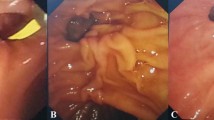Abstract
Introduction/aim
Periampullary diverticula (PAD) discovered incidentally during endoscopic retrograde cholangiopancreatography are usually asymptomatic, but can be a source of significant morbidity. The size of the diverticula and position of the papilla in relation to the diverticula are variable. The twofold aim of this study was to determine the prevalence of PAD in adult Indian patients and technical success of endoscopic retrograde cholangiopancreatography (ERCP).
Methods
Patients with PAD (group I) were prospectively entered into a database from May 2006 to May 2007. Diverticula were categorized based on size into small (<1.5 cm) and large (>1.5 cm). Papilla was arbitrarily defined as type A when located outside the diverticulum and type B when the position was intradiverticular. Requirement of needle knife papillotomy (NKP), sphincterotomy, and overall success/failure of the procedure were recorded. One hundred consecutive patients without PAD undergoing ERCP served as controls (group II).
Results
PAD were present in 46 (7.5%) of the 600 patients undergoing ERCP for various indications (group I). Mean age of patients with PAD (51 ± 15 years) was significantly higher than control group (39 ± 17 years) (p < 0.001). Of the 46 diverticula, 26 diverticula (56.5%) were large. In small diverticula, the papilla was extradiverticular (type A) in all 20 (100%) patients, whereas in the group with diverticula >1.5 cm only 57% was extradiverticular. Successful cannulation was achieved in 97% (45/46). NKP was done in six patients, five of whom had type A papilla. There was a significant high rate of NKP inpatients without PAD compared with patients with PAD (p = 0.001), whereas the rate of endoscopic papillotomy (EPT) was similar in both groups. Complete common bile duct (CBD) clearance was achieved in 93% patients in PAD group as compared with 96% in the non-PAD group (p = nonsignificant). Complications after ERCP were similar in both groups.
Conclusion
PAD were present in 7.5% of patients. Fifty-six percent of PAD were large and in the vast majority (76%) papilla was extradiverticular in location. PAD were not associated with an increased risk of EPT-related complications.


Similar content being viewed by others
Abbreviations
- ERCP:
-
Endoscopic retrograde cholangiopancreatography
- PAD:
-
Periampullary diverticula
- EPT:
-
Endoscopic papillotomy
- NKP:
-
Needle knife papillotomy
References
Labo DN, Balfour TW, Iftikhar SY, Rowlands BJ (1999) Periampullary diverticula and pancreaticobiliary disease. Br J Surg 86:588–597
Lotveit T, Osnes SM (1988) Juxtapapillary duodenal diverticula. Endoscopy 20:175–178
Kirk AP, Summerfield JA (1980) Incidence and significance of juxtapapillary diverticula at endoscopic retrograde cholangiopancreatography. Digestion 20:31–35
Kennedy RH, Thompson MH (1988) Are duodenal diverticula associated with choledocholithiasis? Gut 29:1003–1006
Wilk PJ, Mollure J, Danese CA (1973) Jaundice and pancreatitis caused by a duodenal diverticulum. Am J Gastroenterol 60:273–279
Boix J, Lorenzo-Zúñiga V, Añaños F, Domènech E, Morillas RM, Gassull MA (2006) Impact of periampullary duodenal diverticula at endoscopic retrograde cholangiopancreatography: a proposed classification of periampullary duodenal diverticula. Surg Laparosc Endosc Percutan Tech 16:208–211
Leivonen MK, Halttunen JAA, Kivilaakso EO (1996) Duodenal diverticulum at endoscopic retrograde cholangiopancreatography: analysis of 123 patients. Hepato-Gastroenterology 43:961–963
Waugh JM, Johnston EV (1955) Primary diverticula of the duodenum. Ann Surg 141:193–200
Whitcomb JG (1964) Duodenal diverticulum: a clinical evaluation. Arch Surg 88:275–278
Tham KCT, Kelly M (2004) Association of periampullary duodenal diverticula with bile duct stones and with technical success of endoscopic retrograde cholangiopancreatography. Endoscopy 36:1050–1053
Author information
Authors and Affiliations
Corresponding author
Rights and permissions
About this article
Cite this article
Tyagi, P., Sharma, P., Sharma, B.C. et al. Periampullary diverticula and technical success of endoscopic retrograde cholangiopancreatography. Surg Endosc 23, 1342–1345 (2009). https://doi.org/10.1007/s00464-008-0167-7
Received:
Revised:
Accepted:
Published:
Issue Date:
DOI: https://doi.org/10.1007/s00464-008-0167-7




